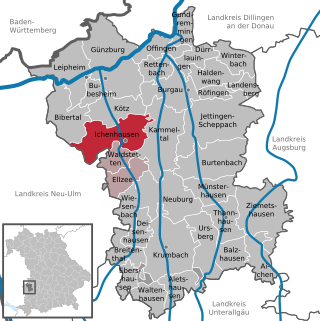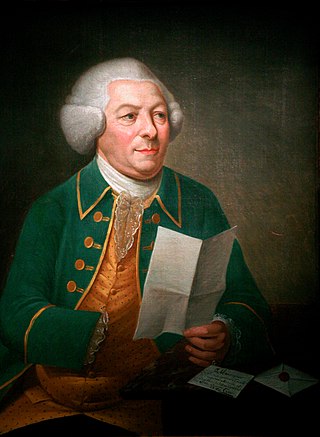Judah ben Samuel of Regensburg, also called Yehuda HeHasid or 'Judah the Pious' in Hebrew, was a leader of the Chassidei Ashkenaz, a movement of Jewish mysticism in Germany considered different from the 18th-century Hasidic movement founded by the Baal Shem Tov.
Isaac ben Moses of Vienna, also called Isaac Or Zarua or the Riaz, is considered to be one of the prominent rabbis of the Middle Ages. He was probably born in Bohemia and lived between 1200 and 1270. He attained his fame in Vienna and his major work, the halachic guide known as the Or Zarua a compilation of halachic decisions and legal rulings, was very popular among Ashkenazic Jewry. He was a member of the Chassidei Ashkenaz and studied under many scholars, including the Ra'avyah, Rabbi Yehudah HaChasid, the Sar mi'Kutzi and Rabbi Elazar Rokeach. He was among the teachers of Rabbi Meir of Rothenburg.
Landesrabbiner are spiritual heads of the Jewish communities of a country, province, or district, particularly in Germany and Austria. The office is a result of the legal condition of the Jews in medieval times when the Jewish communities formed a unit for the purposes of taxation. As the community had to pay certain taxes to the government, the latter had to appoint someone who should be responsible to it for their prompt collection, and who consequently had to be invested with a certain authority. The office of Landesrabbiner had no ecclesiastical meaning until the 18th century, when the various governments began to consider it their duty to care for the spiritual welfare of the Jews. Such ecclesiastical authority, owing to the strictly congregational constitution of the communities, never took root among the Jews.
Josel of Rosheim was the great advocate ("shtadlan") of the German and Polish Jews during the reigns of the Holy Roman Emperor Maximilian I and Charles V. Maximilian I appointed him as governor of all Jews of Germany, a position which was confirmed after his death by his grandson, Charles V.
Rabbi Isaac ben Jacob or Yitzhak ben Yaakov, nicknamed "ha-Lavan" or "the white" was a 12th-century rabbi of Bohemia. He was a Tosafist and liturgical poet who flourished at Prague in the late 12th century.

The Leibzoll was a special toll that Jews had to pay in most European states from the Middle Ages to the 19th century.
Menahem ben Saruq was a Spanish-Jewish philologist of the tenth century CE. He was a skilled poet and polyglot. He was born in Tortosa around 920 and died around 970 in Cordoba. Menahem produced an early dictionary of the Hebrew language. For a time he was the assistant of the great Jewish statesman Hasdai ibn Shaprut, and was involved in both literary and diplomatic matters; his dispute with Dunash ben Labrat, however, led to his downfall.
David ben Naphtali Fränkel or David Hirschel Fränkel, was a German rabbi.
Joseph Colon ben Solomon Trabotto, also known as Maharik, was a 15th-century rabbi who is considered Italy's foremost Judaic scholar and Talmudist of his era.

Ichenhausen is a town in the district of Günzburg, in Bavaria, Germany. It is situated on the river Günz, 9 km south of Günzburg.
Israel of Krems was an Austrian rabbi who flourished in the 14th and 15th centuries. He was the great-grandfather of Israel ben Petahiah Isserlein, who quotes him in his commentary on Rashi to the Pentateuch, section "Wayeḥi." Israel was the author of Haggahot Asheri, notes on Rabbeinu Asher's Talmudic compendium, printed with the text. Grätz identifies Israel of Krems with the Israel whom Emperor Rupert appointed, by a decree of May 3, 1407, chief rabbi of all the German communities, giving him a certificate declaring him to be a great Talmudic scholar and a good man.

The original Regensburg Synagogue, erected between 1210 and 1227, was an edifice in Old Romanesque style in Regensburg, southern Germany, on the site of the former Jewish hospital, in the center of the ghetto, where the present Neue Pfarre stands. Two etchings made by Albrecht Altdorfer of the synagogue shortly before it was destroyed on February 22, 1519, provide the first portrait of an actual architectural monument in European printmaking. In 1519 following the death of Emperor Maximilian, who had long been a protector of the Jews in the imperial cities, extracting from them substantial taxes in exchange, the city of Regensburg, which blamed its economic troubles on its prosperous Jewish community, expelled the 500 Jews. The Jews themselves had demolished the interior of their venerable synagogue, on the site of which a chapel was built in honor of the Virgin. According to a chronicle the exiles settled, under the protection of the Duke of Bavaria, on the opposite bank of the Danube, in Stadt-am-Hof, and in villages in the vicinity; from these they were expelled in the course of the same century.
Anton Margaritha was a sixteenth-century Jewish Hebraist and convert to Christianity. He was a possible source for some of Martin Luther's conception of Judaism.

Herz Cerfbeer of Medelsheim was a French Jewish philanthropist. He was a contractor to the army, and employed his wealth and his influence with the French government in promoting the material and spiritual welfare of his coreligionists. The government permitted him to settle at Strasburg, in opposition to the wishes of the authorities of that city, who zealously enforced the law excluding Jews.
Kalonymos or Kalonymus is a prominent Jewish family who lived in Italy, mostly in Lucca and in Rome, which, after the settlement at Mainz and Speyer of several of its members, took during many generations a leading part in the development of Jewish learning in Germany. The family is according to many considered the foundation of Hachmei Provence and the Ashkenazi Hasidim.

From about 1590 on, there had been a Portuguese Jewish community in Hamburg, whose qehilla existed until its compulsory merger with the Ashkenazi congregation in July 1939. The first Sephardic settlers were Portuguese Marranos, who had fled their country under Philip II and Philip III, at first concealing their religion in their new place of residence. Many of them had emigrated from Spain in the belief that they had found refuge in Portugal.

The history of the Jews in Speyer reaches back over 1,000 years. In the Middle Ages, the city of Speyer, Germany, was home to one of the most significant Jewish communities in the Holy Roman Empire. Its significance is attested to by the frequency of the Ashkenazi Jewish surname Shapiro/Shapira and its variants Szpira/Spiro/Speyer. After many ups and downs throughout history, the community was totally wiped out in 1940 during the Holocaust. With the fall of the Iron Curtain in 1989 Jews again settled in Speyer and a first assembly took place in 1996.

The history of the Jews in Cologne dates to 321 C.E., when it was recorded in a census decreed by the Emperor Constantine I. As such, it is the oldest European Jewish community north of the Alps. The community quickly established itself in what came to be known as Cologne's Jewish quarter, building its first synagogue by 1040 C.E. The Crusades put an end to peaceful coexistence with Christians in 1096 C.E. Despite the Archbishop's protection many Jews were killed and their synagogue destroyed. The community regained its economic and religious life until about 1300 C.E., when the Christian majority again applied pressure. The community's fortunes improved and worsened a number of times into the 20th century. Before the 1930s, it consisted of 19,500 people. After the end of World War II it had been almost entirely extinguished due to Nazi destruction, expulsion and murder. Currently it numbers approximately 5,000.
Ephraim ben Isaac ben Abraham of Regensburg also sometimes called Ben Yakir, was a 12th-century German tosafist and liturgical poet who was known for his keen intellect, his numerous piyyutim and for controversy refusing to recognize any post-Talmudic authority.
















